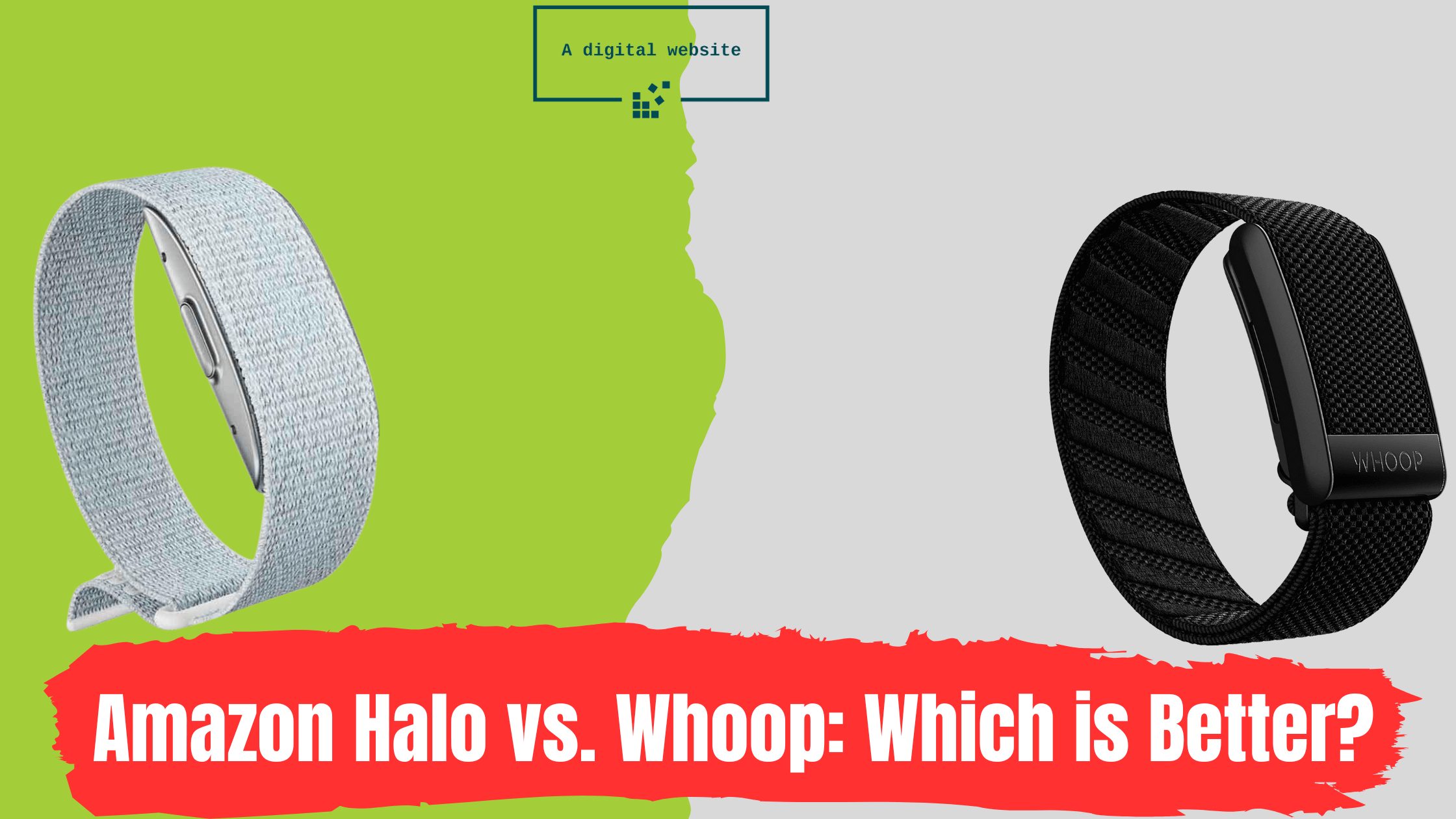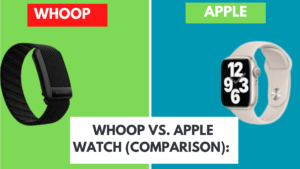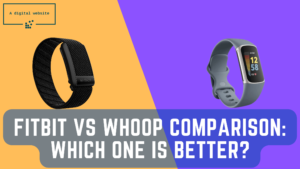Brands like Apple, Fitbit, Fossil, and Garmin have long been dominant players in the smart wearable market, but now they face competition from newcomers like Amazon’s Halo and Whoop. Both track your health and fitness metrics, helping you achieve your fitness goals. These two trackers are so similar that buyers often find it challenging to choose.
In this direct comparison guide between the Amazon Halo Band and Whoop 4.0, we’ll highlight their standard features and differences. We’ll compare them in several key areas where it matters most.
Amazon Halo vs Whoop: Comparison Chart
| Feature | Amazon Halo Band | Whoop 4.0 |
| Display | No | No |
| Steps Counter | Yes | No |
| SpO2 Monitoring | No | Yes |
| Sleep Tracking | Yes | Yes |
| Body Composition Analysis | Yes | No |
| GPS | No | No |
| Water Resistance | Up to 50 meters | Up to 10 meters |
| Battery Life | Up to 7 Days | Up to 5 Days |
| Subscription | $3.99/mo | $30/mo |
Amazon Halo vs. Whoop: Design
Amazon Halo and Whoop stand out from most other fitness trackers. They lack a screen and resemble fashionable fabric wristbands. While they look pretty similar, a few design elements differentiate these two trackers.
Amazon Halo:
Firstly, unlike Whoop, the Amazon Halo strap doesn’t have a clip over the dial but features a Velcro closure. It uses a textured fabric strap that feels durable, comfortable, and non-irritating to the skin. The strap is also resistant to water and sweat. With its minimalist and sleek design, the Halo suits both male and female wrists.
Weighing in at just about 23 grams, the Amazon Halo is lightweight enough to provide comfort throughout the day. The tracker also boasts water resistance of up to 5 ATM, meaning you can wear it in the shower, pool, beach, and beyond.
As mentioned earlier, the Halo Band lacks a screen. However, it does have a side button that allows you to reconnect the tracker to the app, turn built-in microphones on/off for tone analysis, and more.
Whoop:
The Whoop strap is slightly thicker and more comprehensive than the Amazon Halo. It comes with a clasp mechanism to secure the tracker in place. The strap utilizes a thicker fabric, which may be less aesthetically pleasing but offers greater comfort and is suitable for outdoor sports activities. The clasp allows you to adjust the tightness of the strap around your wrist.
What’s great is that you can opt for a Whoop sleeve for any attire, a bicep band, or body clothing to place the tracker away from the wrist, which can be useful for certain workout styles and active pursuits.
The new Whoop 4.0 tracker has an IP68 rating and is water-resistant up to 10 meters for two hours. Like the Halo, it lacks a screen, meaning users must start and stop tracking certain activities via the accompanying app. The tracker also doesn’t have any buttons.
A well-thought-out solution of the Whoop 4.0 is its unique battery pack that attaches to the tracker, allowing users to charge it without removing it. The battery itself charges via USB-C.
Amazon Halo vs. Whoop: Fitness and Health Tracking
Fitness and health tracking are fundamental features of any fitness tracker, monitoring your daily activity and providing detailed analysis at the end of the day. Fortunately, both Amazon Halo and Whoop offer a wide range of health and activity statistics, encouraging users to lead an active, healthy lifestyle.
Amazon Halo
Amazon Halo includes vital fitness and health monitoring capabilities such as step tracking, heart rate monitoring, and sleep analysis. Moreover, it monitors periods of activity and inactivity, assesses movement intensity, and calculates calorie expenditure, utilizing this information to offer a clear assessment of activity levels.
Halo’s sleep tracking features include sleep stages, wake and sleep times, and sleep temperature. The app analyzes all sleep data with other health indicators to calculate a sleep score.
Amazon Halo offers a body composition feature that utilizes your phone’s camera to measure body fat percentage, which is considered a better health indicator than BMI (body mass index) or weight alone. It provides:
- A personalized 3D body model to track progress over time.
- Detailed nutrition information (such as recipes and weekly menus).
- Recommended workouts.
The Halo tracker can automatically detect and classify your activities into vigorous, moderate, and light. The app monitors your heart rate throughout your activities.
From the app, you can also access hundreds of home workout programs, daily meditations, and sleep support guides from Halo Fitness experts and partners, such as 8fit, Aaptive, Exhale, Lifesum, SWEAT, Orangetheory, and others.
Another notable feature of the Amazon Halo Band is tone analysis, which uses two microphones in the tracker to analyze the tone of your voice, determine your emotional state, and assess how you sound to others. While this also raises some privacy concerns, users can turn off the microphones at any time using the side button on the tracker.
In contrast to Whoop, heart rate monitoring in Halo is relatively basic. The app does not display advanced heart metrics such as resting heart rate, heart rate variability (HRV), or respiratory rate, which is disappointing.
Another important note is the lack of SpO2 (blood oxygen saturation) monitoring, available even in entry-level fitness trackers. Additionally, it lacks an ECG sensor, meaning it cannot detect heart rhythm irregularities.
Finally, most health and fitness features require users to subscribe to Halo. With it, you’ll have access to basic statistics such as steps and heart rate, a few workout programs, and sleep metrics.
Whoop
In terms of health-tracking features, Whoop outperforms Halo. It collects various biometric data, including heart rate, HRV, blood oxygen saturation levels, respiratory rate, REM sleep cycles, and skin temperature, to assess strain, recovery, and sleep metrics. These metrics can help you physically and mentally prepare for daily workouts.
Whoop 4.0 provides more accurate data than the Amazon Halo Band thanks to an impressive set of 5 LEDs and four photodiodes. However, it lacks a step counter, which Whoop argues is irrelevant to human physiological metrics.
Whoop takes about fifteen days to calculate your baseline health and fitness statistics and notifies you when you need to realize your potential fully. It can also identify early signs of common illnesses by analyzing changes in your breathing rate and other body metrics. As you rest and recover, the tracker can analyze your health and determine if you need more rest before engaging in intense workouts.
The Whoop companion app can also provide personalized sleep and recovery metrics information. Sleep tracking is one area where Whoop outperforms competitors, offering a detailed breakdown of your nightly activities. Moreover, the in-app virtual coach can assess your performance monthly, highlighting your progress and offering individual workouts, exercises, and nutrition recommendations.
Whoop offers more detailed and targeted health and fitness information than Amazon Halo. However, all the features mentioned, as well as the device itself, depend on a subscription.
Amazon Halo vs Whoop: Apps and Integration
Like all fitness wearables, Amazon Halo and Whoop provide users with companion mobile apps, allowing them to assess their well-being quickly at a glance. Both apps offer many tools, personalized fitness recommendations, and a continuously expanding library of premium-class workout guides and on-demand meditations. Both applications can be found on the Google Play Store for Android devices and the Apple App Store for iPhone and iPad users.
In our experience, the Amazon Halo app simplifies the presentation of user data and provides intuitive navigation. It also displays key health metrics without requiring a Halo subscription, a plus compared to Whoop.
The Whoop app offers simplified and advanced views of user health data, enabling users to compare their metrics using detailed weekly and monthly graphs. It also features a journal monitoring panel where you can log and review your daily activities.
The Whoop Live feature lets you overlay real-time heart rate, recovery, sleep, and strain data onto your videos. Furthermore, membership services such as virtual coaching, workout videos, and Ask Me Anything sessions are accessible directly from the app.
Unlike Amazon Halo, Whoop integrates with Apple Health and Strava to synchronize your activities and personalize your experience. At the time of writing, Whoop is also working on integrating with Google Fit. Amazon Halo does not connect to any third-party apps.
Amazon Halo vs Whoop: Battery
Both wearable devices have similar battery life – nearly a week between charges. However, if you leave the “Tone Analysis” feature enabled, the Amazon Halo Band will only last about two days. Besides being a privacy nightmare (considering Amazon’s reputation), this is also a battery issue, so disabling it is likely the better idea.
The charger provided with the Halo Band fully charges it in less than 90 minutes. In contrast, Whoop 4.0 has a waterproof battery pack that attaches to the tracker and charges it while you wear it.
Amazon Halo vs Whoop: Verdict
In a nutshell, Amazon Halo Band and Whoop 4.0 are similar screenless fitness bracelets with slight differences in feature sets. Price is one of the main factors that sets them apart, along with health and sleep tracking capabilities.
With its initial one-time purchase and additional reasonably priced membership, Amazon Halo Band is likely to be a more economical choice in the long run compared to the subscription-based Whoop model for most people.
However, Whoop 4.0 is a slightly better choice for athletes and fitness enthusiasts overly concerned with every little health and fitness metric. And unlike the Halo Band, you get additional body placement options.
Ultimately, purchasing depends on your budget, concerns, preferences, and usage patterns, so you need to weigh them personally. Alternatively, you can opt for an Apple Watch or Fitbit for fitness tracking and health monitoring, which are one-time purchases and make subscription optional.




